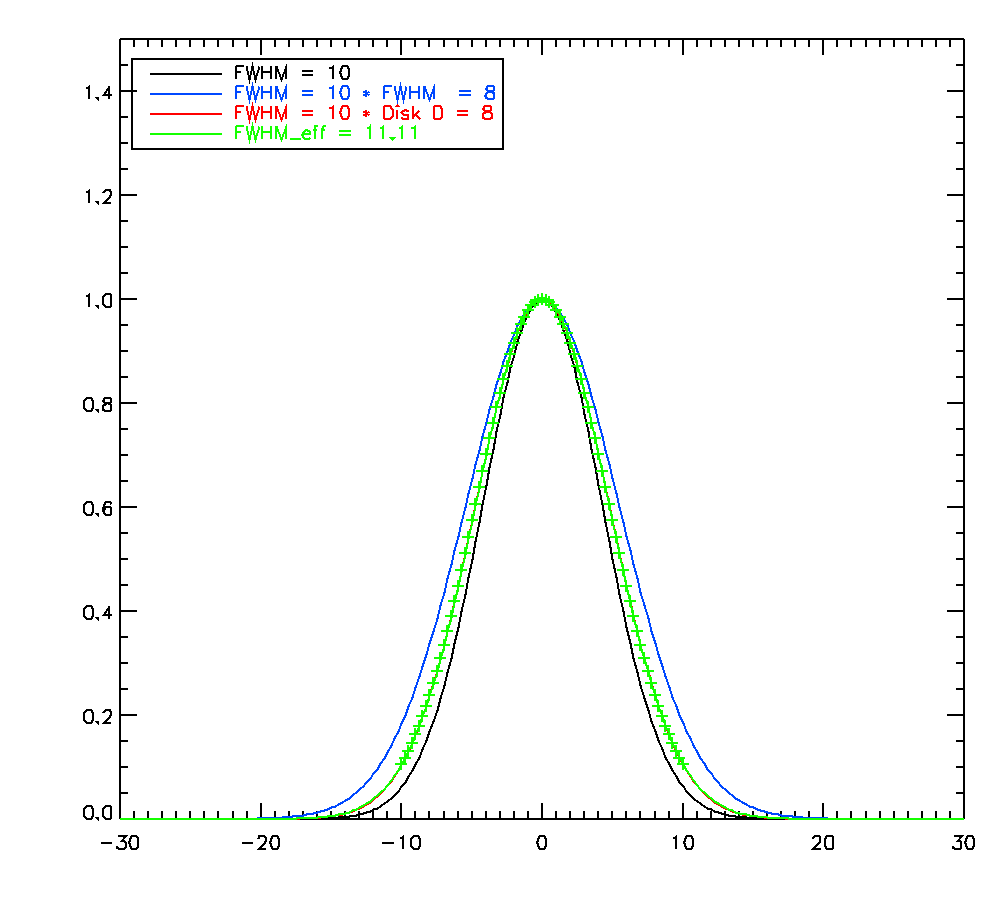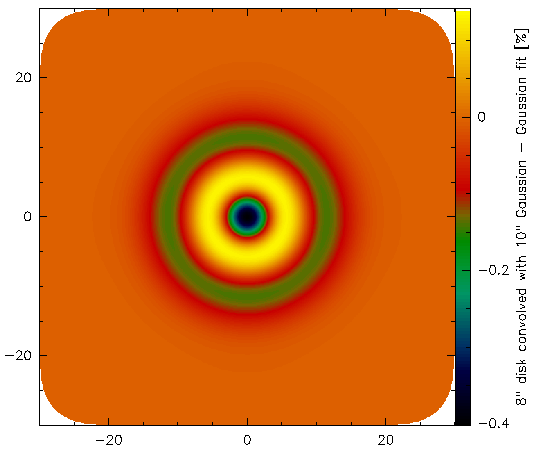|
Size: 1700
Comment:
|
Size: 2060
Comment:
|
| Deletions are marked like this. | Additions are marked like this. |
| Line 4: | Line 4: |
=== NP, June 1st, 2012 === Thanks to Robert's and Samuel's verifications, I found a bug in my simulation (the disk diameter was actually taken as the radius, hence doubling the effective size of the disk and enlarging the broadening). I remove the old plot of May 29 to avoid confusion and provide updated plots here below. The following plot shows the result of the convolution of a Gaussian (FWHM=10 arcsec) by a Gaussian (FWHM=8arcsec) or a disk (D=8arcsec). The difference between the two is indeed not very significant. {{attachment:disk_convol_D=8_max_frac=0.1.png}} |
|
| Line 15: | Line 25: |
| We convolve a true gaussian by a disk and obtain an effective beam that is no longer gaussian. A gaussian can however be fit (with moderate accuracy) around the peak. Restricting to the region where the effective beam is larger than 0.7 times the maximum, we obtain the following distortion pattern {{attachment:fwhm_planet.png ||width=400}} |
First estimations of this effect were wrong and have been removed to avoid confusion, please see above at June 1st. |
Offline Processing Results
NP, June 1st, 2012
Thanks to Robert's and Samuel's verifications, I found a bug in my simulation (the disk diameter was actually taken as the radius, hence doubling the effective size of the disk and enlarging the broadening). I remove the old plot of May 29 to avoid confusion and provide updated plots here below.
The following plot shows the result of the convolution of a Gaussian (FWHM=10 arcsec) by a Gaussian (FWHM=8arcsec) or a disk (D=8arcsec). The difference between the two is indeed not very significant.

RZ, May 30 2012
The figure fwhm_planet.png gives effective FWHM ~16 and 20arcsec for an 8arcsec disk convolved with 10 and 17arcsec Gaussians (input FWHM) correspondingly. This cannot be correct ! The upper limits for the resulting FWHM can be calculated for a convolution of a Gaussian with FWHM=8arcsec instead a disk: sqrt(82+102)=12.8 and sqrt(82+172)=18.8arcsec. To get the correct numbers I calculated the 2 cases, i.e. convolved an 8arcsec disc with FWHM=10 and 17arcsec Gaussians. The resulting sources are very well represented by Gaussians with FWHM of 11.1 and 17.7arcsec (no restrictions for the fitting). The difference of the resulting sources and the Gaussian fits are presented below. The discrepancy is -0.4 to +0.14% for the convolution with a FWHM=10arcsec and much below 1% for the convolution with a FWHM=17arcsec Gaussian. The effective FWHM in figure fwhm_planet.png therefore do not represent the correct values - or do I have a problem in reading this figure ?


NP, May 29 2012
In preparation for beam studies on Mars, we wanted to estimate the impact of Mars diameter (8 arcsec these days) on the determination of NIKA's FWHM.
First estimations of this effect were wrong and have been removed to avoid confusion, please see above at June 1st.
